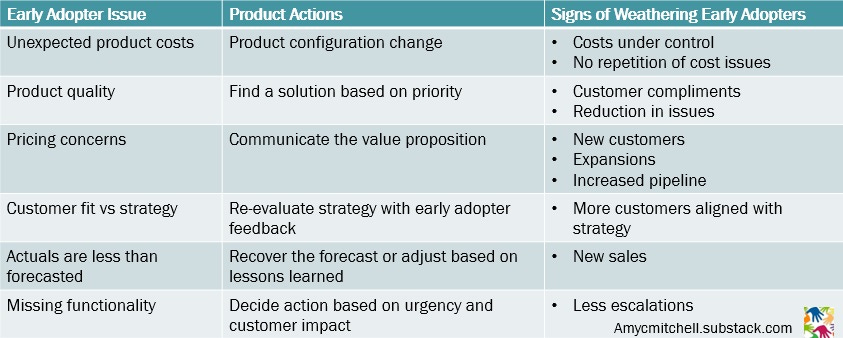Weathering Early Adopter Customers
Being resilient to product challenges and organization dynamics
Your early adopter customers are ordering your product and using it. Why isn't the whole team celebrating this new level of customers using the product? Why is the leadership team scrutinizing every potential customer?
For the first time, your product decisions are being questioned. Your product team questions each requirement. Your product's financials are being deeply reviewed.
Why Are Early Adopter Customers Challenging?
What could be causing this change since your product's launch?
The likely culprit isn't you - it is organizational dynamics!
All of these questions are likely making you feel defensive. The major cause is your organization. While you have immersed yourself in your product and made the early customers successful, your organization has changed.
Organizational dynamics that hit product managers are:
Hierarchy changes such as reorgs
Strategic alignment of your product to business objectives
Cross-functional team changes
As your small product becomes bigger, each new customer is a challenge to the organization.
Organizational dynamics take time to be absorbed by the affected teams. Each early adopter customer puts pressure on a team or challenges sensitivities.
Perceptions of your performance and your product are changing rapidly.
This situation hits product managers frequently as the early adopter customers set precedents that the organization might not be ready to handle. Let's discuss how to survive your early adopter customers.
Communicate Transparently
Communicate successes and challenges transparently with the product team and with stakeholders. This is 2-way communication where:
you listen carefully to concerns
You acknowledge and accept responsibility for change
Focus on cross-functional relationships. Look for the weakest links in meeting business objectives. The highest cost period is adding those early adopter customers.
Items to discuss in your 2-way communications are:
Lessons learned in customer onboarding - hidden costs that are difficult to recover?
Pricing feedback - too high or too low?
Customer satisfaction - is the product what the customer expected?
Hitting the sweet spot of your market - are these your ideal customers?
Forecast vs actuals - real customers compared to modeled customers?
Critical functionality - missing any key features for customers?
Keep your active listening skills sharp! Stakeholders and cross-functional teams who were silent before the early adopter customers are going to be vocal about their concerns.
Develop an Improvement Plan
There is a lot to learn from each early adopter customer. Take in the different perspectives of the product team and stakeholders.
Share the feedback and address it. Demonstrate tangible results:
Provide urgent fixes to customers
Reduce manual processes that cause stress internally
Provide subject matter help to frontline teams dealing with customers
Attack recurring business issues with simplifications
Another tricky part of early adopter customers is that the issues go outside your core product and processes: internal disconnects and other organizational issues surface. As the product manager, you must bring in executive sponsors to help with resources. You need this sponsorship to quickly settle internal priorities by confirming your findings. See presenting to executives for more.
Be sure each issue gets a home in your product:
Urgent recovery items get prioritized in the next iteration
Urgent business issues are factored into your roadmap
The remaining items are documented in lessons learned and consolidated into upcoming product initiatives
During this time of change in handling early adopter customers and organizational dynamics, summarizing the feedback into a written improvement plan helps weather the early adopter issues.
Stay Positive and Proactive
As you develop the improvement plan with your product team, continue to communicate your product's value proposition. By adapting to the changes, your value proposition continues to improve. You will use this material frequently as you communicate the improvement plan.
You've gotten a lot of feedback as you handle the early adopter customers and organizational change. Keeping an optimistic point of view is crucial since the changes take time. As a leader, you need to give your product team time to absorb changes.
Keep track of the changes and decisions - even small changes - to celebrate the team's progress. Don't forget to let the product team, stakeholders, and customers know their feedback is being handled. Watch for signs of improvement and send lots of thank you notes!
Conclusion - Weather the Challenges of Early Adopter Customers
Embrace the opportunity to improve - even with tough challenges from the early adopter customers. Organizational changes add challenges because leaders are skeptical of the value of the early adopter customers.
Take these steps to show the strategic value and potential of your product:
Communicate transparently about product concerns coming from early adopter customers
Develop an improvement plan that shows the product aligns with business objectives
Celebrate all improvements from the early adopter customers
With persistence and determination, your product comes through the early adopter stage stronger and with executive sponsors.
Want to know what happened after a recent article? Premium subscribers get a peak behind the scenes of a recent newsletter. Last week’s backstory was about being assertive without enemies. Navigating Assertiveness Safely
Connect to Amy on LinkedIn, Threads, Instagram and X/Twitter







